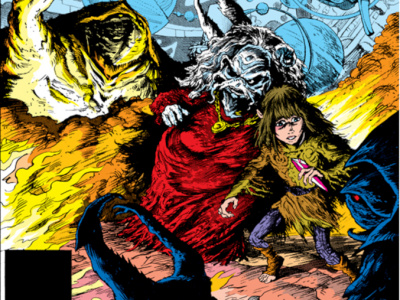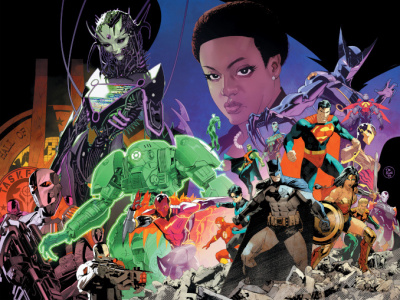
A few weeks ago at the San Diego Comic-Con, we sat down with DC President and Publisher Paul Levitz for our annual talk about the state of the comic business and DC's place in it. In Part 2, we talk about economic effects on the distribution channels, DC’s relationship with mass, its approach to event titles and its MMORG under development. In Part Three, we talk about the status of DC’s relationship with Flex, the Zuda Web comic site, film plans and
Do you predict any differences in how sales in the different channels will respond to the economic conditions?
The comic shop owners are still more vulnerable to the high intensity-high value customer. Luckily a high proportion of our customers are in industries that have been doing relatively well—high technology kinds of things tends to pop up fairly frequently in the descriptions of jobs in our field, so hopefully that’ll be sustaining. The bookstore side of the world, I think, is just vulnerable to all of the challenges that book publishing is having now. Even if the graphic novels are a very bright spot in their world, and they seem to be, book publishing is not having an easy time right now.
Isn’t that as much due to trouble in the retail area as consumer demand?
Again, I don’t think you can easily isolate the pieces. There are challenges in the retail environment certainly. There are challenges in the consumer world. There are challenges in the product mix. The behavior that graphic novels are exhibiting, with more people coming to them and sales rising, shows that people are willing to go to a bookstore to buy books if you give them a book they’re interested in, but there haven’t been a lot of great growth categories the last couple of years. We’ve been a real standout. It’s possible with right kind of creativity there might be other standout categories as well, that could help get through this.
One of the retail sectors that’s doing better these days (the Walmart part of it at least) is mass; the lower priced retailers seem to be weathering the storm better than full-price retailers. What’s the current status of DC’s efforts to sell in that channel?
It hasn’t been a key sector for us for publishing for the last few years. They’re obviously great allies for us in our licensing business and are terrifically supportive of Batman—we did some great business there as a result. I think we’ll see more opportunities to explore that as we get settled with Random House, which has an effective distribution and sales mechanism for these guys, but we’re really still at the stage with Random of maximizing the first steps of the game—making sure we produce enough product to get through the system. We’ve got a few challenges of demand outstripping supply in the first few months, both on the key projects, the Watchmen and Dark Knight related material, but even on some of the relatively mundane stuff where we weren’t correctly anticipating demand. We’re slowly working with them to move out into wider and wider portions of their distribution system.
Switching to the editorial side of the business, so much of the periodical business these days is driven by events and there are inevitable comparisons between Marvel and DC. Are you happy with the sales of your recent event books and with your direction with editorial events?
We’ve had decent numbers on the most recent couple of event projects that we’ve done. The numbers Marvel achieved on Secret Invasion were probably higher by a good margin than Final Crisis. We never like to seem them lapping us on anything, but occasionally they do. We have to accept that as part of the game. Occasionally we lap them.
I think the long-term strength always is dependent on the individual execution of the individual titles. We continue to press to make the events the rare and special things they ought to be and keep enough momentum going on the titles in between them.
So it’s an execution issue, not a matter of the philosophy or how you approach events? It’s more the specific story?
It all starts with the story. If we sat here and dissected any of the patterns of any of the events that any of the major publishers have done over the years, you’d look at it and say, this one might have been too much, this one might have been too few, this one didn’t have a direct enough connection. Go back to the old “Red Skies” tie-ins with Crisis on Infinite Earths 28 years ago. There’s always a way to back seat drive them and look at ways it could have been done better. In the end the stories that matter are the stories that are really well told that get the people excited.
Speaking of excited, for the second half of this year, other than selling tons and tons and tons of Watchmen, what are you excited about editorially?
My challenge to answering questions like that is I’m not immersed enough in the day-to-day of the editorial to know what’s coming in the second half of this year.
A lot of it for me right now, is riding this change in the distribution to its good effect. We’re at such an exciting moment in terms of touching more consumers and changing the behavior of people to introduce comics to them in a wider fashion. I think it’s absolutely fascinating. I was talking to Bill Willingham this morning about Fables. We’re up to the tenth trade paperback now. It’s massively stronger than the ninth in the series was. We’re in more points of sale, more people are picking it up, more people seem to be enjoying it. It seems to be getting stronger in both major channels of distribution at the same time.
If we can continue to work these changes in our system effectively and build this way, it really opens enormous new opportunities for us and we have to figure what they all are and get moving on them.
Last year we talked in a theoretical sense about how DC might use its MMORG to drive comic readership, and we talked about some different options. Now the game’s being introduced here. What did you decide on ways to use the MMORG to drive comic readership?
We have some tentative decisions of some forms we want to use, none of which we are ready to announce at this point. We’re trying to put all the pieces together. You can see at this show the first test demonstrations of the game, which seem to getting very positive response. The way you build a massively multiplayer game, interestingly, is in many ways is backward from how you build a comic. You build your assets first, and your environment first, and how the universe works first before you build your specific stories that you’re telling. So we’re still early enough in the process that we’re just beginning to get the storytellers from the comics side tied in with the massively multiplayer team to run along in parallel and figure out how to put the pieces together.







